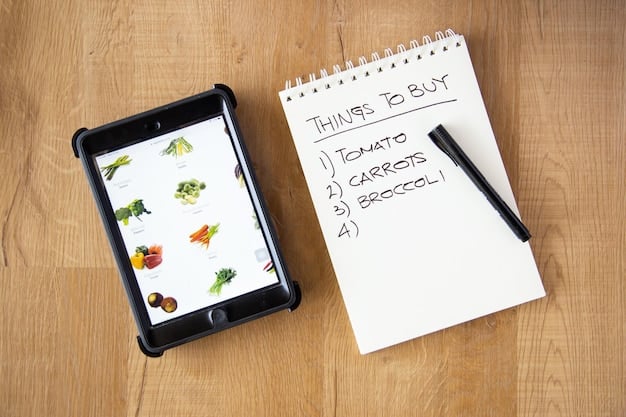Single Dad Savings: Cut Grocery Bills by $500+ Per Year

Single dads can save over $500 annually on groceries by implementing strategic shopping techniques, utilizing budget-friendly recipes, and maximizing available resources and discounts in the US.
Being a single dad comes with its own set of financial challenges, and grocery shopping can quickly become a significant expense. But what if you could significantly reduce your grocery bill without sacrificing the quality of meals for you and your children? This article uncovers practical tips and strategies on how single dads can save $500+ per year on groceries in the US, empowering you to manage your budget more effectively.
Smart Shopping Strategies for Single Fathers
Saving money on groceries begins long before you even step into the store. Planning and preparation are key to avoiding impulse buys and ensuring you’re only purchasing what you need. These strategies can help you optimize your shopping trips.
Plan Your Meals
Creating a weekly meal plan is one of the most effective ways to cut down on grocery costs. By knowing exactly what you’ll be eating each day, you can create a focused shopping list and avoid buying unnecessary items.
- Review Your Pantry: Before making your meal plan, check what ingredients you already have on hand to avoid buying duplicates.
- Theme Nights: Consider theme nights (e.g., “Taco Tuesday,” “Pasta Wednesday”) to streamline meal planning and ingredient usage.
- Involve Your Kids: Get your children involved in the meal planning process to ensure they’re happy with the choices and reduce food waste.
Meal planning not only saves money but also promotes healthier eating habits and reduces stress around meal times.

Create a Detailed Shopping List
A shopping list is your best defense against impulse purchases. Stick to it religiously and avoid wandering aimlessly through the aisles. Organize your list by grocery store sections to make your shopping trip more efficient.
Using a shopping list keeps you focused on what you need, preventing you from spending money on items you don’t really need.
Leveraging Budget-Friendly Recipes
Choosing the right recipes can significantly impact your grocery bill. Opt for meals that utilize inexpensive ingredients like beans, lentils, rice, and seasonal produce. These foods are not only budget-friendly but also packed with nutrients.
Embrace One-Pot Meals
One-pot meals are cost-effective and time-saving, perfect for busy single dads. Dishes like soups, stews, and casseroles can be made in large batches and enjoyed throughout the week.
Cook at Home More Often
Eating out can quickly deplete your budget. Cooking at home allows you to control ingredients and portion sizes, slashing your food expenses. Experiment with simple, delicious recipes that are easy to prepare.
- Batch Cooking: Prepare meals in large quantities on the weekends and freeze individual portions for easy weeknight dinners.
- Leftovers: Repurpose leftovers creatively to minimize waste and create new meals.
- Simple Recipes: Focus on recipes with fewer ingredients, as they tend to be more economical and faster to prepare.
Preparing meals at home allows you to control costs and portion sizes, contributing to both a healthier lifestyle and a healthier budget.
Maximizing Discounts and Resources
Take advantage of available discounts, coupons, and resources to further reduce your grocery expenses. There are several ways to find bargains and stretch your dollar further. Here are some ways to maximize savings:
Utilize Coupons and Apps
Digital coupons and cashback apps can offer significant savings on groceries. Check store flyers, websites, and apps like Ibotta, Rakuten, and Coupons.com for available deals.
Coupons and apps can help you save money on the groceries you already plan to buy.

Shop Store Brands
Generic or store-brand products are often just as good as name-brand items but cost significantly less. Opt for store brands whenever possible without sacrificing quality.
- Compare Labels: Check the ingredient lists of store brands and name brands to ensure similar quality.
- Start Small: Begin by trying store brands of items you frequently purchase to see if you like them.
- Read Reviews: Look for online reviews of store-brand products to get insights from other shoppers.
Switching to store brands can result in noticeable savings over time, without compromising on the quality of your family’s meals.
Check for Price Matching Policies
Some stores offer price matching, which means they’ll match a competitor’s lower price on the same item. Take advantage of this policy to ensure you’re getting the best deal possible.
Reducing Food Waste
Food waste is a major drain on your grocery budget. By taking steps to minimize waste, you can save money and reduce your environmental impact. Here are some tips to reduce food waste:
Store Food Properly
Proper storage can significantly extend the life of your groceries. Learn how to store different types of foods to keep them fresh for longer.
Freeze Strategically
Freezing is a great way to preserve food that you won’t use immediately. Freeze fruits, vegetables, meats, and even leftovers to prevent them from spoiling.
- Portion Before Freezing: Freeze food in individual portions or meal-sized containers for easy use.
- Label Everything: Always label frozen items with the date and contents to avoid confusion.
- Use Freezer Bags: Squeeze out excess air from freezer bags to prevent freezer burn.
Freezing strategically ensures that you can enjoy your groceries for longer and reduce the amount of food that ends up in the trash.
Get Creative with Leftovers
Instead of throwing away leftovers, find creative ways to repurpose them into new meals. Leftover roasted chicken can become chicken salad or tacos, while leftover vegetables can be added to soups or frittatas.
Gardening and Growing Your Own Food
Consider starting a small garden to grow some of your own fruits, vegetables, and herbs. This can be a fun and rewarding way to save money on groceries and provide fresh, healthy food for your family.
Start Small
You don’t need a large yard to start a garden. Even a few potted plants on a balcony or windowsill can provide a surprising amount of fresh produce.
Grow What You Use Most
Focus on growing the fruits, vegetables, and herbs that you use most frequently in your cooking. This will maximize your savings and ensure that you’re always using fresh, homegrown ingredients.
- Herbs: Herbs like basil, mint, and parsley are easy to grow in small containers and can add a lot of flavor to your meals.
- Tomatoes: Tomatoes are a popular choice for home gardens and can be used in a variety of dishes.
- Lettuce: Lettuce is easy to grow and can provide a steady supply of fresh greens for salads.
Gardening allows you to reconnect with your food, save money, and enjoy fresh, homegrown produce with your family.
Community and Government Assistance Programs
Explore whether you qualify for any community or government programs that can help you with grocery costs. These programs are designed to support families in need and can make a significant difference in your budget.
Supplemental Nutrition Assistance Program (SNAP)
SNAP, formerly known as food stamps, provides financial assistance for low-income individuals and families to purchase groceries.
Local Food Banks
Food banks are community organizations that provide free groceries to individuals and families in need. Find a local food bank in your area and take advantage of their services.
- Feeding America: Feeding America is a national network of food banks that can help you find a food bank in your local area.
- Local Churches: Many churches also operate food pantries and offer assistance to those in need.
- Community Centers: Community centers often have information about food assistance programs and resources in your area.
Utilizing community and government assistance programs can provide essential support and help you stretch your grocery budget further.
| Key Point | Brief Description |
|---|---|
| 📝 Meal Planning | Plan meals weekly to avoid impulse buys and reduce waste. |
| 🛒 Store Brands | Opt for generic brands for similar quality at lower prices. |
| 🌱 Grow Food | Start a small garden to grow your own produce and herbs. |
| 💰 Use Coupons | Utilize coupons and cashback apps for extra savings on items you already buy. |
Frequently Asked Questions (FAQ)
▼
Meal planning helps you avoid impulse purchases and food waste by knowing exactly what you need. This ensures that you only buy necessary ingredients and use them efficiently, reducing overall expenses.
▼
In many cases, yes. Store-brand products often have similar ingredients and nutritional value as name-brand items but are sold at a lower price. Try them out to see if they meet your standards and save money.
▼
Lettuce, tomatoes, and herbs like basil and mint are great options for beginner gardeners. They are relatively easy to grow, even in small spaces, and can provide fresh produce for your meals.
▼
Cashback apps offer rebates on specific grocery items when you purchase them and upload a photo of your receipt. Over time, these rebates can add up to significant savings on your grocery bill.
▼
Store food properly, freeze excess ingredients or leftovers, and get creative with repurposing leftovers into new meals. By minimizing waste, you not only save money but also reduce your environmental impact.
Conclusion
Saving money on groceries as a single dad is entirely achievable with the right strategies. By implementing smart shopping techniques, choosing budget-friendly recipes, maximizing discounts, reducing food waste, and exploring community resources, you can easily save $500 or more per year, freeing up your budget for other important needs.





